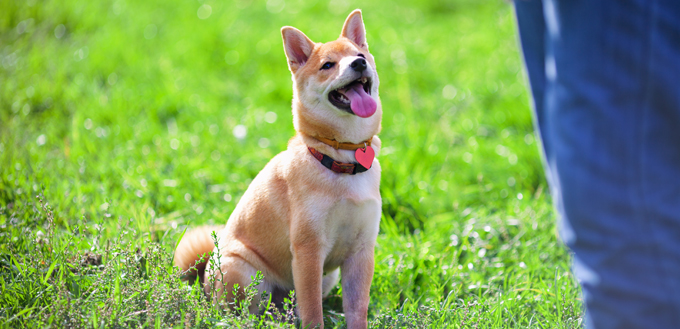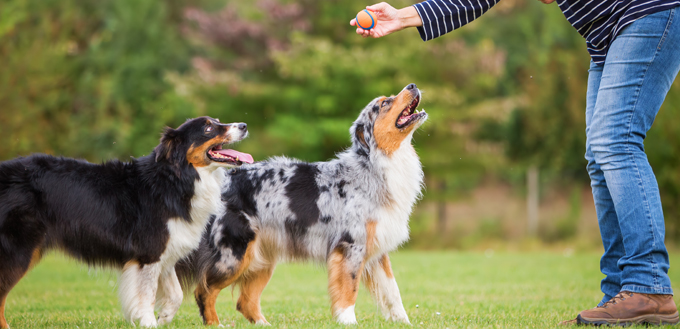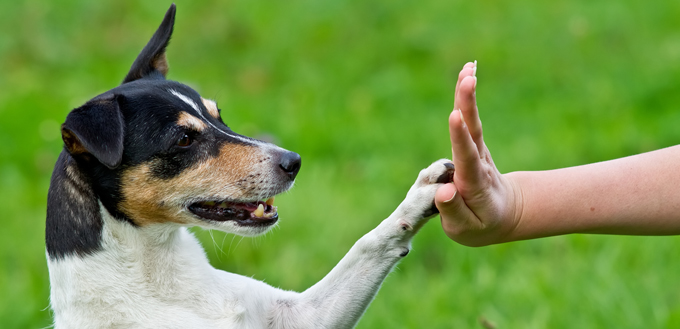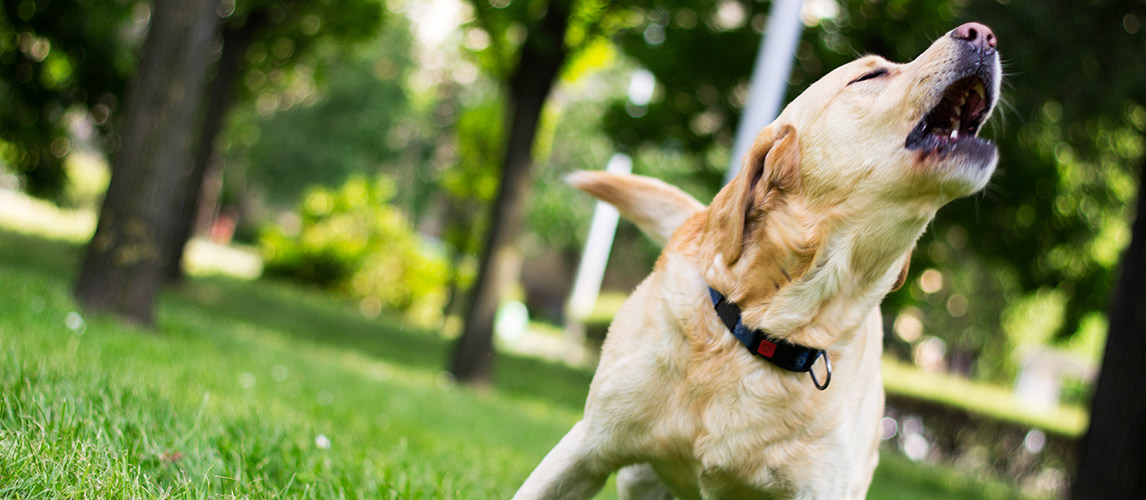As with many aspects of life, there are many types of dog training. You will find people who are huge fans of one type of dog training only to be told by someone else that it does not work! Ultimately, it is up to you to find training methods that suit you and your pup.
We have reviewed all the top approaches to dog training and have come up with the top 7 techniques to help new dog parents out. Check out these different training styles to help you find the best dog training programs for your particular situation.
1. Basic Obedience Training Using Positive Reinforcement
You may also see this referred to as reward-based training, force-free dog training, or R+ training. It is often considered the gentlest approach to behavioral training and uses rewards to teach basic commands and desired behavior.
Positive reinforcement training motivates your dog because they get a positive consequence for the desired action. It is very popular amongst dog trainers and is a widely used dog training method in dog training classes. You can find help on how to find a trainer for your dog here.
The basis of positive reinforcement training is that you use a ‘marker’ to let the dog know that they have done something correct and a treat as a reward. The ‘marker’ could be a clicker (there is more about this later) or simply using a word such as ‘yes’ or ‘yep’. It is best to keep things simple in positive reinforcement training.
This training style does require you to get some rewards in place but that does not always have to be food. Part of the positive training methods is to find out what motivates your particular dog. It could be a tasty treat (such as cheese or apple), it could be a ball game, a quick tug of war game, a tummy scratch, or just warm words and praise.
Pros of Positive Reinforcement Training
One of the advantages of positive reinforcement dog training is that it can be used to help dogs learn all types of dog behavior ranging from housebreaking to agility training. It is very popular amongst inexperienced dog owners and dogs love it! It makes training sessions a joy for owners and dogs and helps to build a strong bond.
It is a very effective training method for shy and nervous dogs who may not cope with other training methods.
Cons of Positive Reinforcement Training
The main disadvantage of positive reinforcement techniques is that they do require a lot of patience. You also need to be alert all the time so that you can use training treats as soon as your dog does something good. You may want to invest in a dog treat pouch that you wear around your waist so that the treats are always at hand. Head over to our review of the best dog training treats.

2. Clicker Training
Clicker training is very similar to the positive reinforcement approach of traditional dog training. It is now one of the most popular dog training methods. The clicker takes the place of the ‘marker’ word to reward good behavior. The clicker allows the trainer to instantly reward desired behavior in a consistent way. Clickers all sound the same so several people can use them and there will be no difference for the dog.
In clicker training, you start by teaching your dog to associate the click sound with a treat – it is a purely positive training method. You don’t even ask your dog to do anything, you just click and reward. Soon your dog will build up a positive association with the click.
Then, you build up an association with certain behavior and a click. Tell your dog to ‘sit’ and as soon as they do, you click and give them a treat. You may have to start this by using a treat lure above their head but they will soon get the hang of it.
Pros of Clicker Training
This type of dog training is very precise. That makes it highly suitable for complex actions such as rolling over where you need to reward at the exact moment and may need to break the move up into several parts.
It is also great for behavior training and agility training.
Cons of Clicker Training
You will have to buy a training clicker and it is yet another thing that you will need to carry around with you. However, many are lightweight and come with belt clips, etc. It also introduces another step into the training process which some people do not like.
They are not that useful when it comes to sorting out existing unwanted behaviors.
3. Alpha Dominance Dog Training Methods
In the wild dogs learn their own place in a pack very quickly. Alpha dominance training relies on you establishing your position in the pack (household) and making sure that your position is higher than your dog’s! You are the alpha dog and therefore in charge.
The focus is on positive punishment and on the use of corrections. In this dominance training, you could use the ‘alpha dog roll’ where you roll your dog onto their back when they exhibit unwanted behaviors. Your dog learns that this behavior is not acceptable. As the alpha dog of the pack, you may also want to use an electric collar or a vibrating collar to correct unwanted behaviors. There is more about this later.
There is a lot of debate, controversy, and variation associated with alpha training. Many dog trainers feel that it is based on floored science and reject the techniques. Others use an adapted version that combines positive rewards with what they term positive punishments. On the whole, this is not one of the dog training methods that we would recommend.
Pros of Alpha Dominance Training
It can be useful for curbing impulses and learning to ignore distractions. It includes sound principles for establishing boundaries.
Cons of Alpha Dominance Training
It is damaging to the bond between humans and dogs. Because it is quite confrontational it can lead to confusion which could be potentially dangerous. This can lead to a deterioration in behavior which may lead to fear, aggression, and even dog bites.
4. E-collar Dog Training Techniques
This is a form of positive punishment training. Bad behavior results in an unpleasant physical sensation. Electronic training using e-collar works at a distance because you don’t have to be close to your dog or have them on a leash.
Electronic training involves physical punishments – it could be a vibration, an electric shock, or even a spray of citronella. You can find out more about how to use e-training techniques in this article.
Pros of Electronic Training
It is a quick and instant way of correcting your dog when you are not close to them. It stops them from choosing to ignore you!
Cons of Electronic Training
E collar training does not tell a dog what they should do. This can result in them being too scared to do anything! It can cause a lot of stress for some dogs.
5. Model Rival Methods
This is a type of specialized dog training that was first developed by a researcher called Irene Pepperberg and she used it on parrots. It has been successfully adapted for dogs too. It is based on your dog learning by example. They spend time with a dog that knows how to obey and behave and they use them as a model.
Pros of Model Rival Methods
This is one of the more gentle specialized dog training methods. It is very useful to expand the skillset that your dog has and to learn polite canine behavior.
It has proved very useful for a professional dog trainer who needs to teach specialist skills in canine education such as for therapy dogs and sight dogs.
Cons of Model Rival Methods
The main disadvantage of this method is that you need another dog for every training session. Also, this training style requires a very well-trained dog so any old dog simply will not do it! It is best reserved for specialized training rather than for everyday tasks and is therefore not that useful for many family dogs.
You may also like our article on: Why Doesn’t My Dog Bark

6. Relationship-based Training
Relationship-based training is a very gentle training approach and is based on the understanding that your dog has feelings. When training dogs in this way, you learn to focus on your dog’s body language so that you can adapt what you are doing accordingly.
You would normally start relationship-based training in a low distraction environment and then build up to working with distractions. The dog’s environment is very important. The aim is for your dog to be happy and secure about the training at all times. It is very similar to positive training and some people consider them to be the same thing.
Pros of Relationship-based Training
It is an excellent foundational training technique and takes your dog’s personality into account. It plays to their strengths and works on their weaknesses. You get to be an expert on dog body language!
Cons of Relationship-based Training
It is a very slow process and can get frustrating for the owner! It is not the best approach if your dog has a strong will and needs a lot of incentive. It also does not work well in a high distraction environment or where there are a lot of other dogs.
7. Science-based Modern Dog Training Methods
Scientific training of dogs is now possible because there is a new field of science-based on the discipline of animal behavior. Science-based dog training techniques have been compiled from studies and experiments conducted by animal behaviorists in the same way as other scientific advances.
In scientific training, the effectiveness of interventions and techniques are properly evaluated to produce up-to-date and well-researched methods instead of relying on old wives’ tales and personal opinions.
This means that scientific training can overlap with several different training methods because some of them have elements that can be scientifically validated. It often just depends on what the dog trainer wants to call them.
Pros of Science-based Methods
It is based on dog behavior so you also become very educated on what motivates your dog and why they do certain things. This makes you a more informed and understanding dog owner.
Cons of Science-based Methods
This is a fast-moving area of research so it is hard to always be up to date. You may have to rely on a training facility or dog trainer to share the latest practice with you.
Why Are There Different Types of Dog Training Methods?
Because there are different types of dogs and dog owners! There are also different situations and different behaviors that people are trying to achieve.
You may be aiming for simple obedience training and some dog trainers will recommend some of the popular dog training methods. However, after a week or so you may find that you are making no progress. This is when you may need to try another approach.
Group classes are great for some dogs but for others, they are a waste of time. If your dog is so interested in the other dogs that they are not engaging with you, you would do better with one-to-one training.
You may also need to pick an appropriate method to tackle particular behavioral problems such as excessive barking. There will always be plenty of opinions on dog training but you know your dog best and it is up to you to find what works for them.

FAQs:
Q: What are the levels of dog training?
Most training starts with encouraging good behavior and discouraging bad behavior as well as teaching some basic commands.
Level 1: teach your dog the basics of house manners such as pooping and peeing outdoors, resting quietly in their crate/bed, and getting used to wearing a harness/collar and leash.
Level 2: now you can move on to some basic commands. You could do this as part of a training class or you could just work on it yourself. The basics usually sit, down, stay and come. At the same time, your dog will be learning their name.
Level 3: this is all about how your dog behaves in public. They need to be able to focus on you and obey the basic commands that you have already taught them in environments that have more distractions. They also need to learn how to interact politely and calmly with other dogs and people.
Level 4: many people are happy to stop at level 3 and simply do some top-up training if their dog is forgetting their manners. However, other owners like to carry on with special training in dog sports, therapy training, protection training, or as part of an agility class.
Level 5: some dogs are not just pets – they have a job to do. Service dogs who work for the military, the police, or as search and rescue dogs undergo very high level and specific training that teaches them to do a job.
If you would like to achieve a qualification with your dog, you could try to pass the Canine Good Citizen Test run by the American Kennel Club. It’s a two-part course that trains both you and your dog. The training usually consists of some structured learning, some fun time, and using reward systems.
Q: What is modern dog training and how is it different from a traditional training method?
Modern dog training is also sometimes called science-based training. It differs from other training techniques because it is based on research. It relies on positive reinforcement and is usually force-free. It is faster than many other methods and has great benefits for both the dog and the owner.
It moves away from traditional techniques such as requiring you to be an alpha in the family. Your dog will be less stressed and full of confidence.
Q: What is the first thing I should teach my puppy?
When you get your new puppy home, the first thing they need to learn is the house rules. The most important of these is that they should only poop and pee outside.
To do this you always reward the desired behavior and never punish them if they have an accident. If you make the pup fearful, they will sneak away to do it and that makes it even harder to correct.
Q: How do you punish a puppy?
Puppies should never be punished. You simply have to catch them being good and give them loads of praise and a reward. As long as a pup gets the right amount of physical exercise, mental stimulation, food, and rest, all you need to do is gently encourage good behavior. Puppies can get a little over the top when they are overtired – very similar to a human toddler. This can be sorted out with a little ‘quiet time’ in their crate to reset.
If you are worried about your pup’s behavior and think that they are developing aggression, consult someone who can provide veterinary advice or a dog behavior expert.
Q: What tools should I use to train my puppy?
To train your puppy you need a leash, a harness or collar, a crate (if you are crate training), and plenty of tasty treats that are suitable for your pup’s age.
You may also want to use puppy training pads but this is optional. You may also want to use a clicker as a marker when your pup has done something good.
Q: How do I establish an alpha position with my dog?
Not everyone thinks that this is necessary. However, it is important that you establish that you are the boss. You can do this by looking them in the eye when you give commands and protecting them from harm. This will earn their respect.
The best way to assert your authority is to have control of the food. Hand-feed every meal from a pouch whilst teaching some basic commands and engagement. This teaches the dog that all good things come from you and earns their respect.






